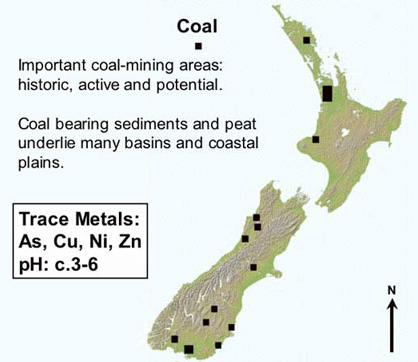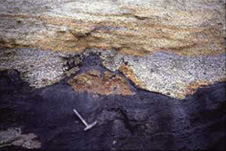Coal occurs in river and lake sediments resting on basement rocks in many parts of New Zealand. Most important mining areas are shown on the map below.

Important coal mining areas in New Zealand- Historic, acitve and potential
 This coal outcrop at Kaitangata, south of Dunedin, has abundant pyrite along the upper margin of the seam. Oxidised pyrite forms the dark brown stains. The pyrite contains arsenic which is released during oxidation..
This coal outcrop at Kaitangata, south of Dunedin, has abundant pyrite along the upper margin of the seam. Oxidised pyrite forms the dark brown stains. The pyrite contains arsenic which is released during oxidation..
- Coal and associated sediments commonly contain sulphur in the form of pyrite (FeS2). Sulphur is highest in coals associated with sediments formed near the sea coast.
- Sulphurous coal exposed at the surface produces sulphuric acid during oxidation (acid rock drainage).
- Pyrite in coal generally contains traces of arsenic, which is released with the acid rock drainage.
- The acid also dissolves other metals from associated sediments. The most common metals dissolved in New Zealand coaly sediments are copper, nickel and zinc.
More information
Related
Introduction
Overview: Geological setting for Metals in the New Zealand environment
- Epithermal Gold
- Mesothermal Gold
- Acid Rock drainage
- Coal
- Metals in groundwater
- Alluvial Gold
- Northland Mercury
-
Hot Springs (in heavy metals)
